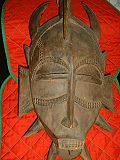Mask
![]()
This article is about face covering - for other meanings see Mask (disambiguation) and Masking (disambiguation).
![]()
The whole article is not sufficiently supported by evidence (for example, itemized). Information without sufficient evidence may be removed soon. Please help Wikipedia by researching the information and adding good evidence.
A mask (from Arabic مسخرة, DMG masḫara 'jester, farce, tease, joke') is a facial covering used mostly in theater and art, and for ritual and religious purposes, often supplemented by a disguise or costume. As a protective mask, it may serve to protect the face or parts of it. The term mask is also commonly used for a covering of the body, from a half mask to a full body mask. In theatre and film, the field of work of make-up artists is referred to as "the mask", and their activity as "mask making", which mainly includes make-up.
According to their origin, masks were plastic structures worn in front of the face made of natural materials such as plant parts, leather, wood, clay or cloth (see also larva). In more recent times, masks are mainly made of plastics. A mask can fulfil very different tasks in different contexts, for example, its wearer can use it to transform himself into a depicted character (see, for example, animal role-playing), or the masking makes it possible to practise new or assumed social roles.
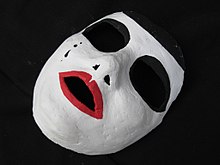
Modern mask from plaster

Stone mask from the pre-Ceramic Neolithic period around 7000 BC, one of the oldest masks in the world (Musée Bible et Terre Sainte, Paris)
Ritual masks
The root of the mask lies in religious acts (cults). Masks are still used today by ethnic groups and indigenous peoples in ritual dances to worship protective deities or to ward off evil spirits. The mask, which covers the face or is worn as a headpiece, is only part of what is understood by it in most ethnic cultures. Costumes made of cloth or plant fibers are an indispensable part of the overall mask. Carved masks are also forms of plastic art; above all, they are part of a ritual or a mask performance or dance. In the process, entities, auxiliary spirits or personified forces of nature that mediate between the world of humans and that of the gods and ancestors are depicted in a lifelike and impressive manner.
Mask performances played an important role, for example, in the kingdoms of Africa: their appearances are manifestations of different systems of education, instruction, social, cultural and economic integration, but also social control up to the judicial and punitive function as well as the exercise and regulation of political power. The wearers of a mask were not simply seen as people in disguise; in the minds of those participating in the ritual, they were the addressed spirits or ancestors themselves. The production of a mask therefore often took place under observance of ritual regulations and in seclusion. Masks could be sacrificed or provided with a special power charge.
For example, among the Hopi and other Native American peoples, carefully masked dancers represent their ancestral and nature spirits during rituals.
Death Masks
Death masks have also been made since ancient times. In contrast to today's use as a reminder of the deceased, they were originally intended to ward off harm or had a spiritual function. The most famous example of this is probably the death mask of Tutankhamun.
Shamanic masks
Rock drawings of animal-human beings are known from the Palaeolithic, which can be interpreted as shamans, for example rock paintings, Les Trois Frères, mixed human-animal beings from the archaeological cultural stage of the Magdalénien around 15,000 B.C. The shamanistic interpretation of animal-human rock drawings is not unambiguous, because animal skulls (without and with fur) were used as head masks by many peoples until the 20th century, so it could also be a matter of depicted hunting scenes. In general, however, the idea prevailed among the peoples who knew shamanism that a mask provided its wearer with access to another world by identifying with the masking, e.g. with a totem animal, or by transforming into the entity which the lave represents (so-called transformation mask) and acquiring its powers.
Protective masks
Some masks are supposed to serve the ritual protection of the wearer. Mask-like demonic grimace faces and fright images are also found in the architecture of medieval churches, e.g. in the form of leaf masks (Gorgon head, Green Man); they are supposed to have apotropaic effects and ward off evil.
· Masks from all over the world
·
Ivory Coast
· 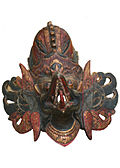
South Asia
· 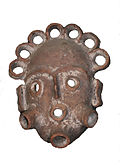
Tunisia
· 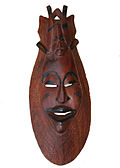
Central Africa
· 
European masks from the stock of the MEK
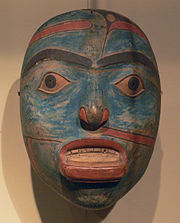
Mask of a mythical Ahan woman of the Haida. Ethnological Museum Berlin, acquired in 1837.
Theater: utensil and makeup
In ancient Greek theatre, actors used typecast masks to better express the emotions of their roles. This type of mask is called a persona.
A laughing and a crying mask (comedy and tragedy) have been symbols of dramatic theatre since Greek antiquity and are still used today in Western culture, for example in travel guides or municipal event booklets, as pictograms for the performing arts. In our time, this symbol usually includes ballet and opera in addition to theatre in general.
In four fixed leather masks that prove distinct types - the best known are the Harlequin and the Bajazzo - they continue to exist in the Commedia dell'arte since the Renaissance. Because of the facial covering, mask then also stands for the figure or role wearing it as a whole, subsequently also for a costumed person, for example in the carnival in Venice.
In Japanese theatre (such as the Nō) and Chinese opera, there are both rigid masks and masklike make-ups.
Transferred to the 19th century, the term mask was also used for the combination of half-mask, costume and role for certain types of roles: The so-called character masks represented, for example, the doctor or Hans Wurst, the so-called national masks the Frenchman or the Spaniard
Today, the mask (in the sense of a "facial disguise") in theatre and film is often only made up, as very few mask makers are skilled in the art of making the theatrical mask. In addition, the highly stylized art form of playing with the mask is not taught comprehensively at directing and acting schools in Germany.
In reference to all these masks, even today in theatre and film the room in which the make-up artist works (although the actors are usually only made up, coiffed, dressed up and trimmed) is simply called "the mask". Today, the play with a mask is additionally used in the theatre specifically in individual scenes, e.g. to represent human feelings and ideas, transcendental or dream realities. Here the mask play makes possible a body-accentuated, expressive and poetic form of the theatre play. As soon as the face is covered, the body and the movement come to the fore. With a full mask, language is also no longer available, which opens up new possibilities of expression.
In the field of the theatrical mask, renowned, very specialized artists such as Stefanie Buss, Stephanie Hermes, Fratinelli de Marchi, Donato Sartori, Erhard Stiefel and Lars Maué work. The play with the theatre mask is cultivated in Scandinavia, in the USA and in Italy by well-known groups. The Berlin mask theatre Familie Flöz celebrates great success with its performances at home and abroad.
Jacques Lecoq developed his theatrical theory based on the concept of the "neutral mask". The study of acting at the École Internationale De Théatre Jacques Lecoq, which he founded, begins with the neutral mask. Commedia dell'arte masks are then taught, and at the end of the year of instruction, acting is done with the red nose, the smallest mask in the world. The red nose is used as a mask by clowns both in the circus and in the theatre.

Symbolic masks for the sad tragedy and funny comedy
.jpg)
Roman theatre masks as gargoyles (Museo Capitolino, mosaic, c. 100 BC)
Search within the encyclopedia
